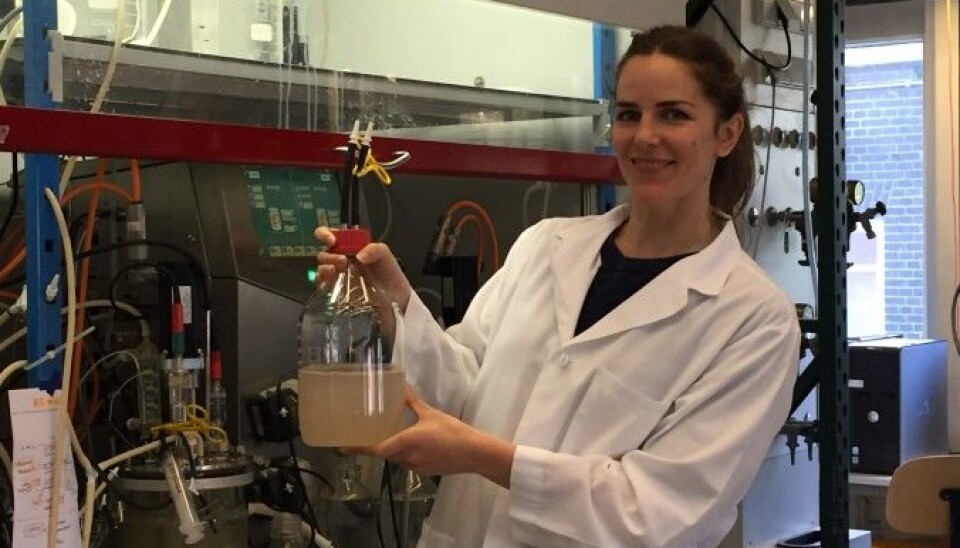An article from Norwegian University of Life Sciences (NMBU)

Scientists grow bacteria that breathe greenhouse gases
Increasing amonts of the lesser known greenhouse gas nitrous oxide in the atmosphere, could become a problem. But researchers are developing new ways of dealing with the emissions.
A clowdy liquid is bubbling in a closed glass pot connected to tubes, pumps and sensors monitoring its vital signs. What sounds more like a patient at an intensive care unit of a hospital, is actually a bioreactor containing bacteria, situated at the Delft University of Technology.
“The bacteria we are growing and studying use nitrous oxide the same way as we do with oxygen: for breathing” explains Monica Conthe, a PhD student and researcher studying these special group of bacteria.
"They are the only consumers for this aggressive greenhouse gas that we know”.
Laughing gas
Greenhouse gases heat up our atmosphere, thus leading to the so called greenhouse effect we are currently observing. Nitrous oxide (N20) is in the same group as the better known gas carbon dioxide (CO2). The compound, commonly known as “laughing gas”, has been increasing in the atmosphere since the beginning of the 20th century, when we started using chemical fertilizers to increase crop yields.
The IPCC (Intergovernmental Panel on Climate Change) estimated the contribution of one molcule N2O to the greenhouse effect to be 300 times higher than one molecule of CO2. This compensates for the relative low concentrations of N2O measured in the atmosphere and explains why this gas comes more and more into focus of scientists.
Unlike for carbon dioxide, we are just beginning to understand the reasons for the increase of nitrous oxide and prediction studies already called it the “greenhouse gas of the 21st century”.
Where does this increase in N2O come from?
Traces of N2O are naturally found in the environment and scientist discover more and more groups of microbes which are able to produce it. However, the question of who exactly is causing the increase of N2O is still a difficult one.
“This is rather complex,” says Monica, “as there are different microbial processes that can produce N2O and in some cases the mechanism by which it is produced remain obscure”.
Hunters
By using chemical nitrogen fertilizers the input of nitrogen in natural environments has been increased. This disturbs a natural balance between the microbes that produce and consume N2O, resulting in the emission of the greenhouse gas to our atmosphere.
However, Conthe explains that there are some microorganisms that can actually consume nitrous oxide.
Instead of using oxygen like we humans do, these organisms can generate energy by “breathing” N2O. The endproduct of that consummation is dinitrogen gas (N2), which is a natural compound of the air we breathe and a climate neutral gas.
What if these bacteria can be used to consume the excessive emissions of N2O?
Conthe describes her research group as “microbe hunters”. In her case she is hunting for rbacteria specialized in consuming N2O. Scientist acheive this by a natural selection from all kinds of bacteria.
For instance, if microbiologists want to isolate organisms that can grow on diesel or other pollutants, they “feed” a diverse community with the pollutant of interest. After a while, the only ones left in the community, will be organisms that are able to consume these compounds.
Monica applied the same principle by feeding her reactor with N2O gas and over time, organisms able to breathe it were the last ones standing.
Helping the “good” bacteria
A potential strategy to avoid emissions of this greenhouse gas into the atmosphere would be to favor the presence of N2O consuming bacteria in ecosystems where it is being produced.
“Rather than trying to avoid its production, why not focus on favoring its consumption?“
The findings from the research at TU Delft can be used to develop strategies for N2O emissions reduction in natural as well as engineered ecosystems.
As an example of such an engineered system, Monica Conthe talks about wastewater treatment plants.
“If research continues on the topic, I foresee N2O-free wastewater treatment plants in the near future.” Wastewater treatment plants are known to contribute to increasing N2O concentrations on our planet.
The outgoing gas streams could be conducted through a bio-filter containing Monicas N2O breathing bacteria to clear it from the greenhouse gas before it exits to the atmosphere.
The same principle can be used in other industries where N2O in off-streams is present, like in nylon production.
The bacteria grown and studied in the big glass pots of TU Delft are not the only example where nature provides us a solution for an environmental problem we face.
“The tools are out there” Monica Conthe finishes our tour through the lab “we just have to figure out how to use and apply them.“






























